A curated list of the most beautiful places in Montenegro that deserve a place on any Balkan travel itinerary.
For such a teeny tiny country, Montenegro really packs a punch.
With an area of less than 14,000 square-kilometres and a population under 650,000 people, it’s one of the smallest countries in the Balkans. And yet Montenegro has somehow still managed to squeeze dramatic mountains and canyons, the lion’s share of the region’s biggest lake, a beautiful stretch of Adriatic coastline and of course the iconic Bay of Kotor into its borders.
From peak to shore, Montenegro is without a doubt one of the most beautiful countries in the region. The irony, of course, is that the capital is known for being one of the most unappealing cities in Europe… But even ugly duckling Podgorica has its charms!
Here is my list of the best places to visit in Montenegro, as explored on our 10-day road trip.
- Also read: 21 best travel tips for visiting Montenegro
Please note: This post contains affiliate links, meaning I may earn a commission if you make a purchase by clicking a link (at no extra cost to you). Learn more.
Watch my Montenegro travel video!
Before we start, here’s a short video we created of our road trip around Montenegro.
How to visit these destinations in Montenegro
Montenegro is perfect for a road trip, so I highly recommend hiring a car and exploring the country at your own pace. Local Rent is my go-to website for car rentals in Montenegro. They work with local agents to offer competitive prices and flexible terms.
→ Browse the my Local Rent to find the perfect rental.
→ Read up on my Montenegro driving tips so you know what to expect!
25 most beautiful places in Montenegro
In no particular order, here are 25 of the most beautiful places to visit in Montenegro.
1. Perast
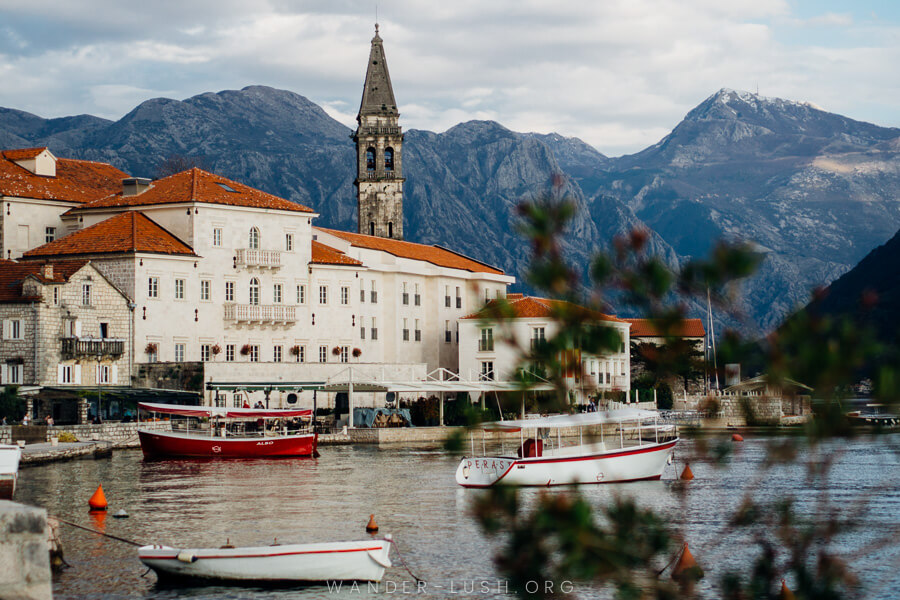
I know I just said ‘no particular order’, but if I had to choose the most beautiful place in Montenegro overall, it would be the harbour town of Perast.
Located in the middle part of the Bay of Kotor, adjacent to the narrow channel that opens out to the Adriatic, Perast is a tiny hillside town sandwiched between the coast and the mountains. Its single main street is overflowing with pretty architecture, crumbling bell towers and romantic seaside cafes. The best thing to eat at said cafes is a slice of Peraška torta, a delicious almond cake and a local specialty.
Perast was established by the Venetians and features grand marble palazzos and picturesque churches. The 18 Renaissance and Baroque palaces along the seafront are a testimony to its glory days as a thriving port. Today, Perast is mostly residential and very peaceful compared to other towns along the Boka Kotorska.
Instead of cruise ships, small boats ply the harbour, ferrying people back and forth to Our Lady of the Rocks. The only artificial island in the Adriatic, it was constructed from old shipwrecks and stones at the site where a vision of the Virgin Mary appeared to two local fishermen.
The island chapel is one of the most unique churches I’ve ever visited. There’s also a small museum that displays artefacts salvaged from shipwrecks in the bay. Perast has its own unique history and culture, and there are many annual festivals that celebrate the town’s seafaring heritage.
Strolling along the harbour at dusk after the day visitors have departed is a wonderful way to soak up the spirit of Perast. It’s just a 20-minute drive from Kotor, but I recommend staying at one of the family-run guesthouses in the hills for a couple of nights.
2. Kotor Old Town
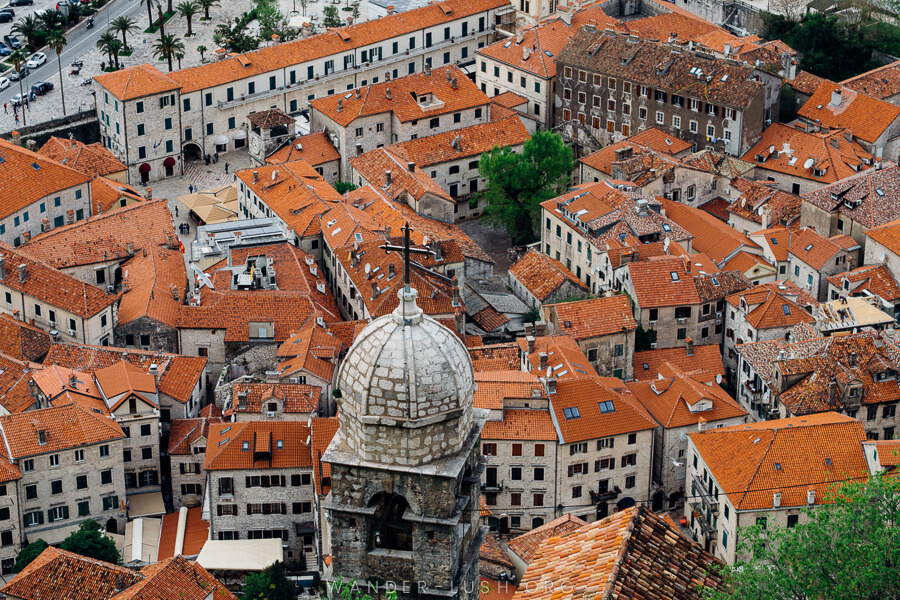
It wouldn’t be a trip to Montenegro without visiting the country’s most popular destination and crowning glory, Kotor. The UNESCO World Heritage Listed Kotor Old Town is among the most enchanting fortified town centres on the Adriatic, and a worthy rival to Dubrovnik or Split.
Medieval Roman churches, Venetian palaces and towering Byzantine towers reveal the legacy of the many different empires that have occupied Kotor over the centuries. Under the shadow of the legendary St. John’s Fort, the myths and tales surrounding Kotor will keep you enthralled, while the sheer beauty of the orange-roofed houses, narrow lanes strung with laundry and resident Kotor cats will have you reaching for your camera at every turn. Entering the Old Town through the gates still marked with Venetian insignia feels like taking a step back in time.
The best way to experience Kotor is by ambling along the cobbled streets in the early morning before the crowds arrive. Climb up to St. John’s (either via the official trail or via the Ladder of Kotor) for a birds-eye view of the rooftops and turquoise bay beyond.
3. Durmitor National Park
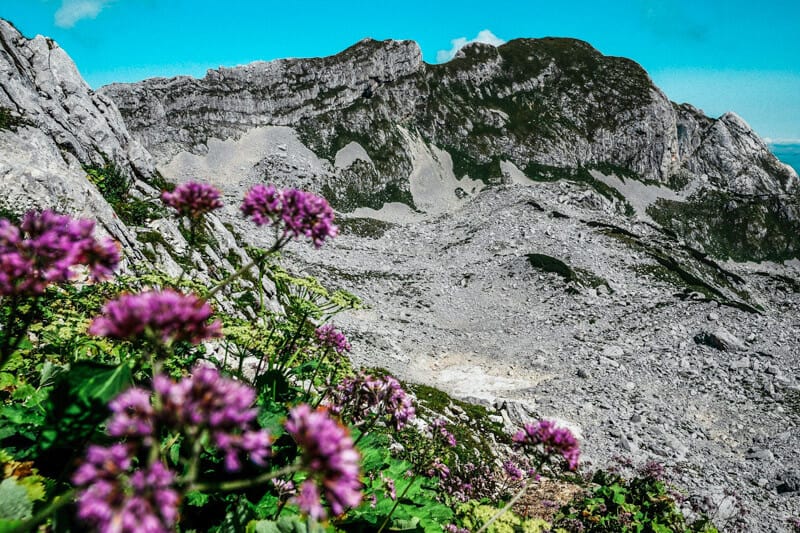
Montenegro is synonymous with the coast and the bay, but the dramatic landscapes of the country’s interior are equally as impressive. Almost the entire eastern half of Montenegro is mountainous. Durmitor National Park in the northern corner is the premier destination for hiking, kayaking, and other adventure activities.
Durmitor sits on a plateau 1,500m above sea level, surrounded by high mountains, glacial lakes and deep canyons. The 150km-long Tara River that flows through the park offers some of the best water rapids anywhere in Europe. Trails are plentiful – the most famous being the day hike to the summit of Bobotov Kuk.
The nearby alpine town of Žabljak (the highest town in the Balkans) is an ideal base for visiting Durmitor and is beautiful in its own right, with wooden cottages, meadows, and roaming flocks of sheep. Don’t miss the hike to Crno jezero, which competes with Bled in Slovenia for the title of ‘most beautiful lake in the Balkans’ (see more below).
This part of Montenegro is particularly beautiful in late spring when the wildflowers come into bloom.
4. Black Lake (Crno Jezero)
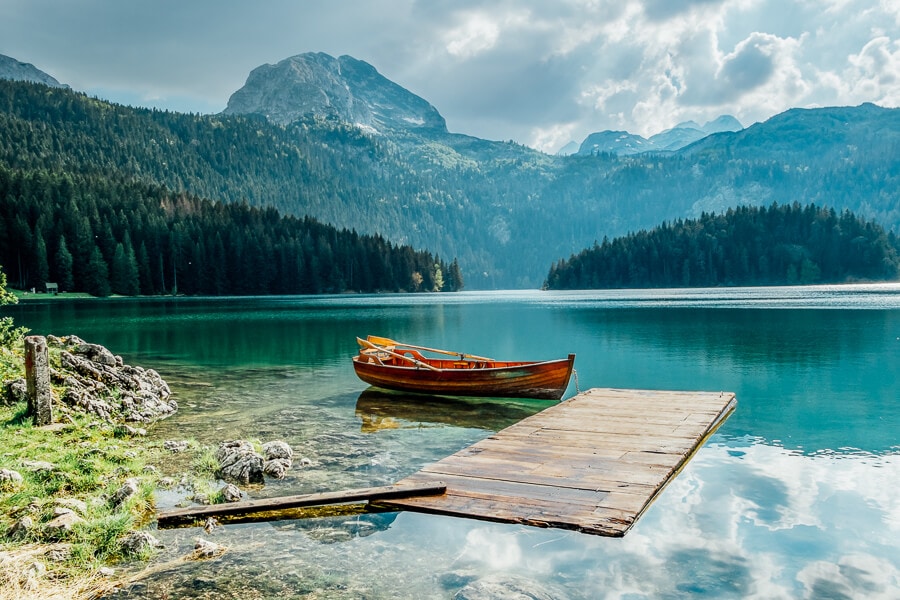
Located in the northern part of Montenegro on Mount Durmitor Crno jezero or ‘Black Lake’ is perhaps the most well-known glacial lake in the country, if not the whole region. Surrounded by dense pine forests and rising hills, Black Lake lies at the foot of Međjed Peak, one of the majestic mountains that forms the Dinaric Alps.
This is no ordinary lake: Black Lake is actually made up of two smaller lakes that are connected by a narrow strait. In the summer, the water channel dries up and reveals two separate bodies of water known as Veliko Jezero (Big Lake) and Malo Jezero (Little Lake). Black Lake is not only the largest, but also the most popular of the 18 glacial lakes within Durmitor National Park.
The lake is easily accessible from the town of Žabljak. A 3.5-kilometre path circles the lake and is perfect for beginner hikers, especially since a delicious Montenegrin feast always awaits at Katun Restaurant at the end of the trail.
5. Lake Skadar
Central Montenegro isn’t just easy on the eye, it’s also bountiful in flora and fauna. The waters of Lake Skadar are shared between Montenegro and Albania, but the richest, marshiest part of the lake lies on the Montenegrin side.
Skadar is the largest lake on the Balkan Peninsula, covering an area of over 500 square-kilometres. Despite its size, it’s a true hidden gem in Europe that has somehow managed to avoid the limelight. It’s a nesting ground for endemic and migratory birds (more than 280 bird species in total). On the other side of the lake, the Albanian city of Skadar is the gateway to the Accursed Mountains.
There are a couple of different ways you can take in the beauty of Skadar Lake. The first is by riding the train from Podgorica to Bar, the last leg of the Belgrade to Bar route, which is counted among the most beautiful train rides in the world. The train runs directly across the lake via a narrow gauge railway.
Here’s a short video we made of the train ride:
I also recommend doing a boat trip on the marshes. Virpazar serves as the main gateway to Lake Skadar National Park and you can always find someone who’s willing to take you out on the water for a couple of hours. From the lake, you can spot Besac Fortress, one of the oldest fortifications in the country. May is the best time to visit Skadar for bird watching. In summer, parts of the lake are covered with a bed of pretty water lilies.
6. Pavlova Strana Viewpoint
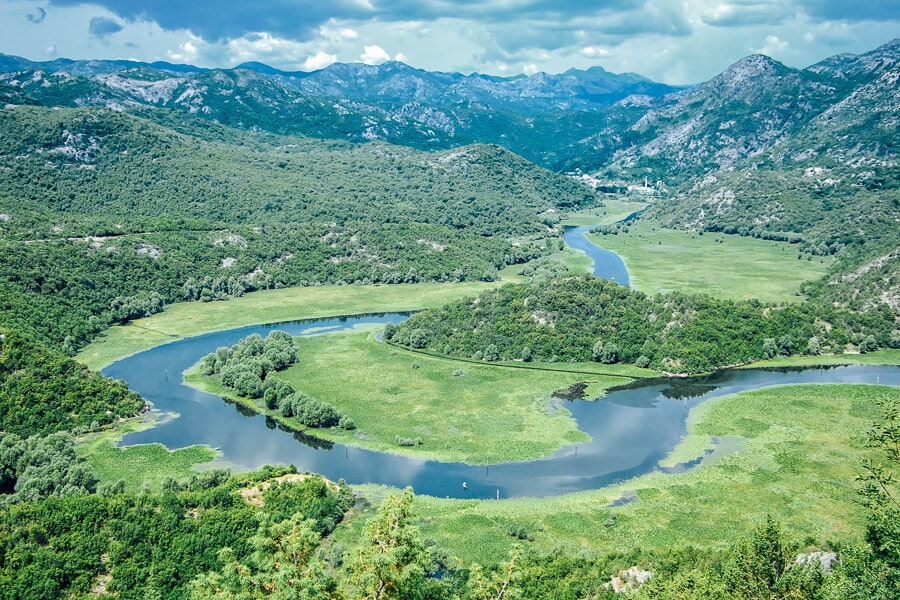
Lake Skadar looks incredible from afar, which is why you must stop at the Pavlova Strana Viewpoint near the cute town of Rijeka Crnojevića for a panorama of the marshes and the horseshoe bend of the Crnojevica River. The viewpoint is located on the northeastern side of the lake and is easy to access form the highway.
The Crnojevica runs for 12.3 kilometres along the northeastern shore of the lake. On a clear day, you get panoramic views of the green hills. On hot summer days, the river dries up, resulting in an abundance of water lilies. When the winter months take over and the river rises again, the water lilies give the river an enchanting emerald appearance.
7. Gornji Stoliv – a hidden gem in Montenegro
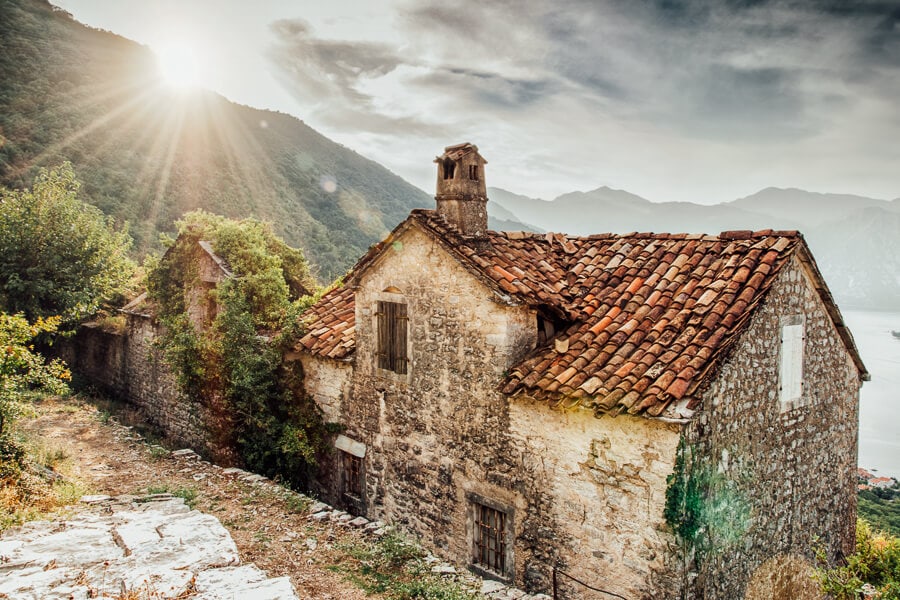
At 250 metres above sea level on the Bay of Kotor, the tiny village of Gornji Stoliv is easy to miss. Yet it’s just a 30-minute drive from Tivat, proving that you can still find authentic beauty a stone’s throw from Montenegro’s bustling modern ports.
The village is home to the parish church of St. Elijah, one of the Nine Sacral Objects in Stoliv. Thanks to its unique bell tower, built in 1883, it is considered one of the most beautiful churches in the entire Boka.
The road that takes you to Gornji Stoliv runs via a centuries-old chestnut plantation, which – along with the camellia flower – is the trademark of Stoliv and the inspiration behind the annual festivals held here.
8. Stari Bar
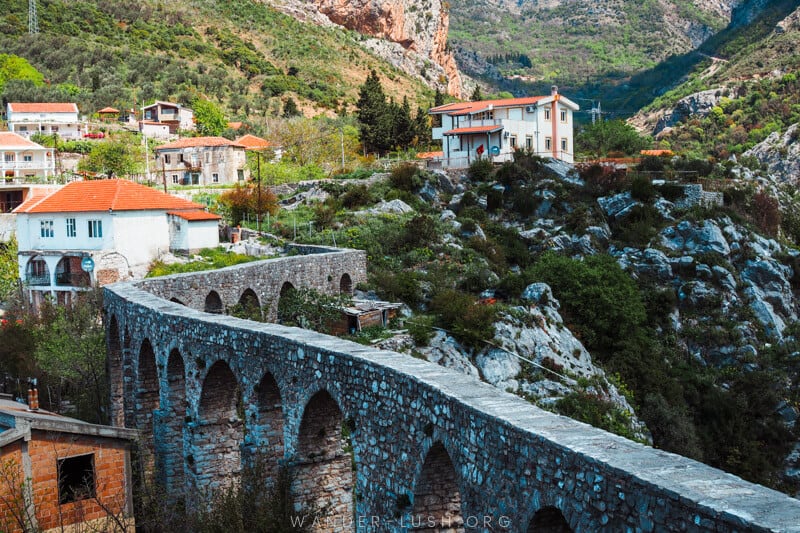
Stari Bar, Old Bar, is a historic town on Montenegro’s southern coast, close to the border with Albania. Set back in the hills away from the sea, it dates back to the Early Middle Ages and is best known for its sprawling castle and Ottoman-built aqueduct.
Bar is a beautiful place with an unfortunate history. In 1979, an earthquake devastated this part of Montenegro, destroying the aqueduct and leaving the town without running water. Residents had no choice but to abandon their homes and relocate to the coast where they established a new town (today’s Bar) and went about rebuilding their lives. Stari Bar was stuck frozen in time.
One of the most wonderful things to do in Montenegro is to ride the train to Bar then head up into the hill to explore the picturesque town of Stari Bar on foot. The complex of crumbling walls, churches and mosques is fascinating.
From the back, you can get a good view of the last remaining spans of the Bar Aqueduct, an incredible feat of engineering that still cuts a beautiful profile as it traces its way through the hills and houses beyond the fortress walls. There are a bunch of sweet restaurants just outside the fortress where you can break for lunch.
The entire area is surrounded by thick olive groves. Standing in Stari Bar for more than 2,000 years, one ancient tree called ‘Stara maslina’ is said to be one of the world’s oldest specimens.
9. Tara River Canyon
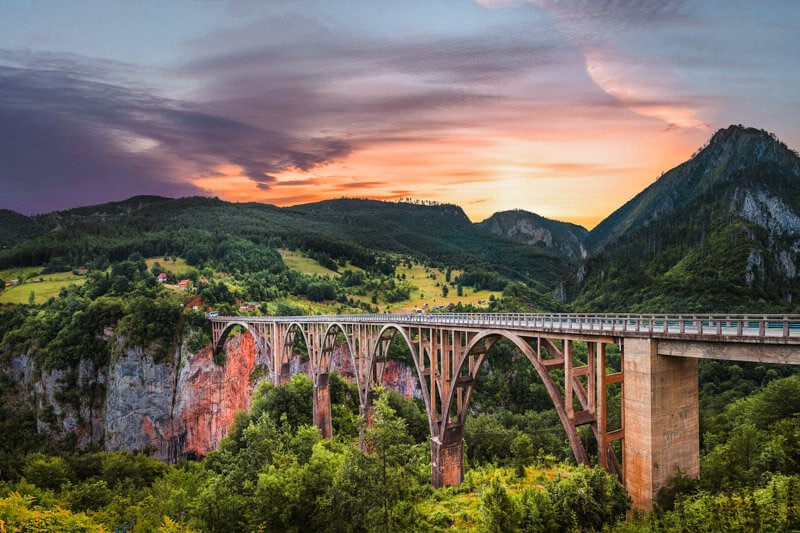
Part of Durmitor National Park, the Tara River Canyon is one of the largest and deepest canyons not just in the Balkans countries, but in all of Europe.
The waterway flows down from Bosnia and Herzegovina where it forms a natural border between the two countries, then opens up into a gorge just outside the Montenegrin town of Zabljak. In late spring and summer, visitors descend on Tara Canyon to go whitewater rafting.
The most beautiful spot along the gorge is Đurđevića Bridge. Constructed in 1940 when Montenegro was part of Yugoslavia, it was the largest concrete arched bridge in Europe at the time. Just a few short years later, during WWII, the bridge was almost completely destroyed in an effort to prevent the Italian advance (incredibly, one of the engineers responsible for the design was involved in the plot to bring it down).
Rebuilt in 1946, the arches beautifully mirror the rolling mountains beyond.
10. Piva River Canyon
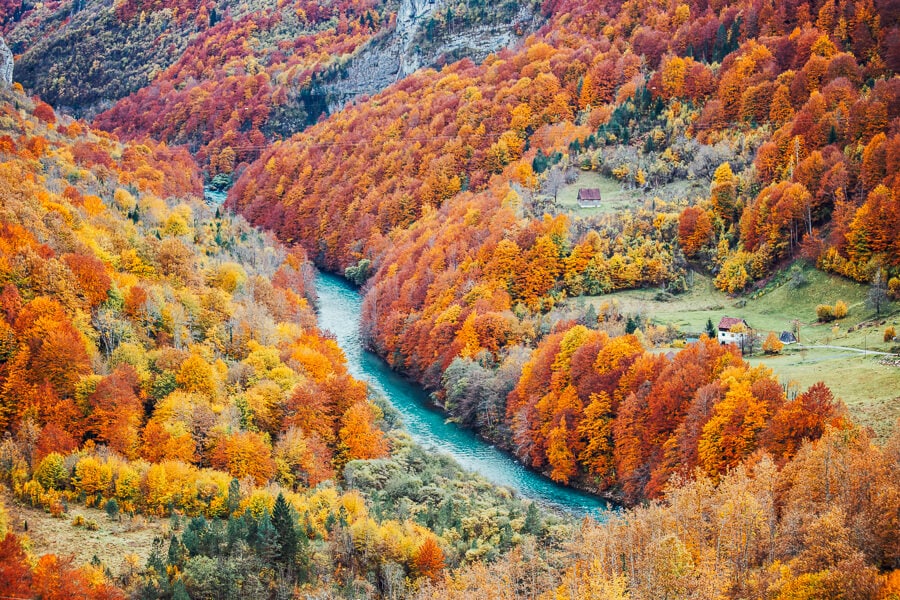
Another one for nature lovers, the Piva River Canyon is situated at the foot of Pivska Mountain in the northwestern canyons of Montenegro. Where the Piva River now runs, the Piva Monastery once stood – it had to be relocated due to the construction of a hydroelectric power plant. The monastery was disassembled stone by stone and moved to a new location.
The 45-kilometre-long Mratinje Dam is a product of the power plant construction. One of the largest artificial dams in Europe, it stands at 220 metres high. The Piva Lake, which is 45 kilometres long and 200 metres deep in some areas, is said to produce the finest drinking water in the Balkans thanks to the clean waters of the river that feeds it.
Come autumn, this part of Montenegro takes on a whole different character as the forested hills change from green to shades of auburn and rust. Contrasted with the turquoise-blue Piva, it makes for a truly memorable scene reminiscent of a painter’s canvas.
11. Bukumirsko Lake & the Komovi Mountains
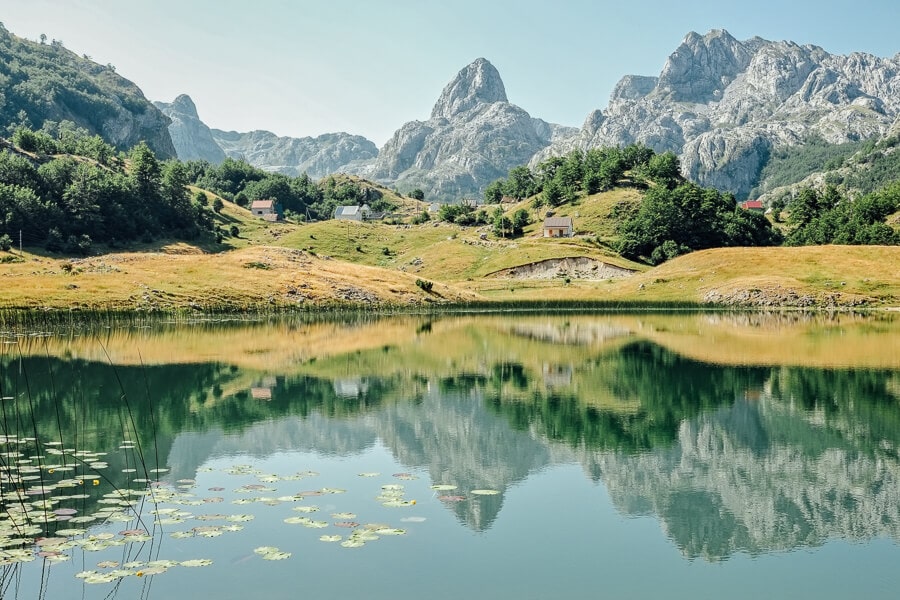
Surrounded by the rugged mountains of Komovi, at 1,443 metres above sea level, Bukumirsko Lake might not be Montenegro’s largest lake (it’s only 130 metres at its widest point), but it’s surely one of the most beautiful.
The Komovi Mountains are one of the most impressive ranges in Montenegro. Thanks to the area’s ecological significance and abundance of flora and fauna, it has been classified as a nature park since 2018. The highest peak, Kom Kučki, stands at 2,487 metres, earning it the nickname of ‘King of the Mountains’.
Lake Bukumirsko is easy to visit as a detour when travelling north from Podgorica via the scenic back road. The final stretch of road to the lake’s shore is a bit rough (you definitely need a 4WD), but the refreshing waters and near solitude you’re likely to meet make the journey worthwhile.
12. Ostrog Monastery
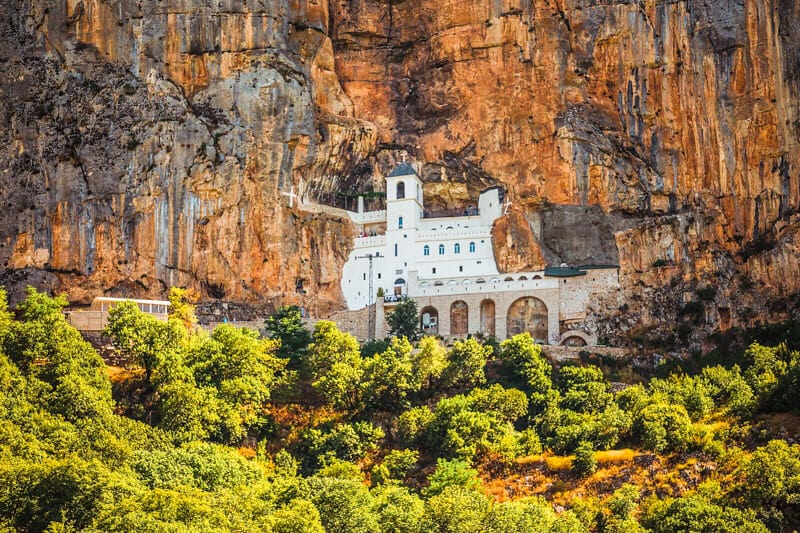
Located close to Montenegro’s second-largest city, Niksic, Ostrog Monastery is the country’s most sacred Orthodox Christian site and a major draw for pilgrims from around the world. Even if you don’t have a religious bone in your body, I’m sure you’ll agree that the monastery is an absolute marvel.
Shimmering white against a bed of ochre stone, Ostrog is perched on a mountain cliff 900m above the lush Zeta valley. The upper monastery dates back to 1665 and is dedicated to St. Basil. It comprises numerous candle-lit cloisters and open balconies set within two large caves, which gives the impression that the monastery has been carved out of the rock.
Viewing Ostrog from the marked lookout points in the valley below is one thing, but climbing the stairs to see it up close is another. The more impressive feature is a set of colourful iconographic mosaics made by pressing tiny pieces of shimmering glass and stone directly into the surface of the rock.
13. Budva Old Town
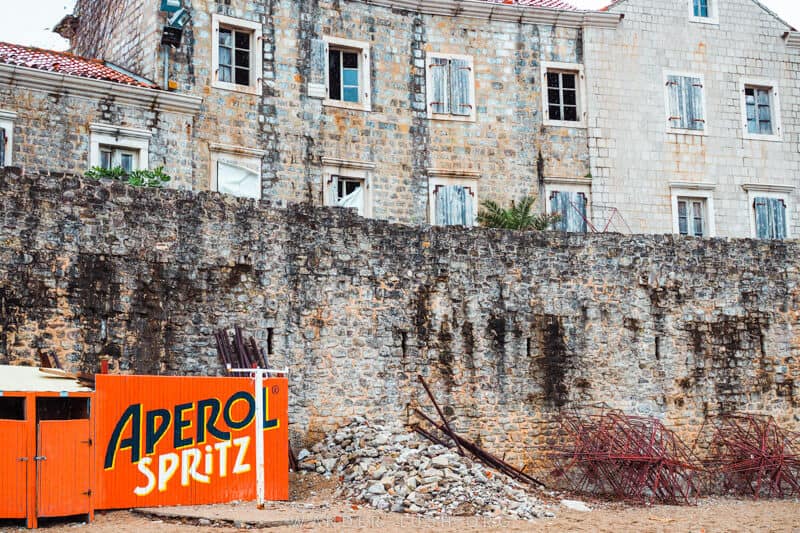
A more glamorous (and touristy) version of Kotor, Budva is the most-visited destination in Montenegro and a popular cruise ship port in the summer months. Jaz beach and the Riviera have become a playground for the rich and famous.
Budva might not be everyone’s cup of tea, but it’s worth braving the crowds to wander the stone alleyways and narrow streets of the medieval fortified city, Stari Grad, which is also a UNESCO World Heritage Site.
It’s smaller than Kotor, but the cobbled paths and Venetian walls are every bit as charming. The popular museum and Gallery of Modern Art are a great place to learn about the area’s history.
14. Sveti Stefan
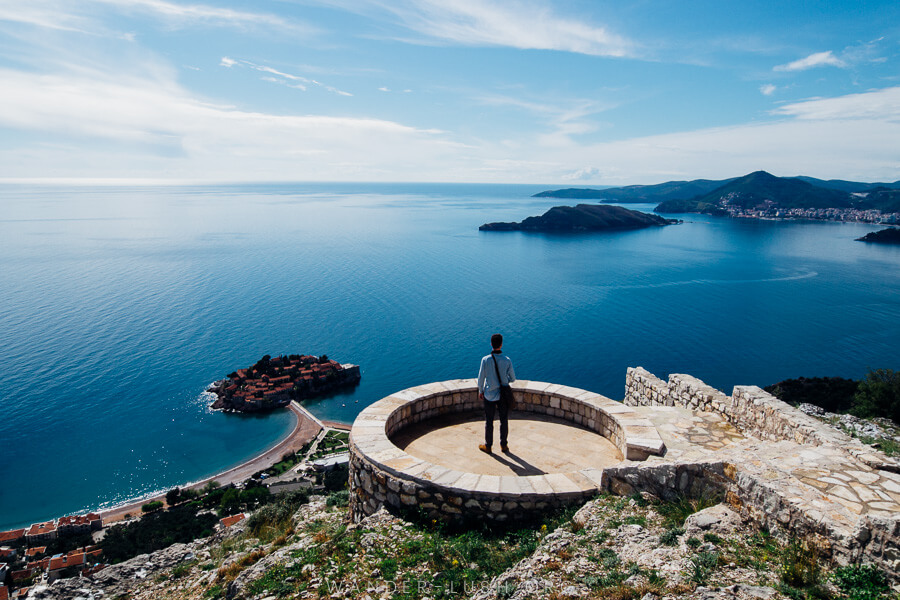
The island of Sveti Stefan is the poster child of Montenegrin tourism, and it’s not difficult to see why. This is without a doubt one of the most beautiful places in Montenegro.
Located off the country’s central coast, just south of Budva and the Bay of Kotor, Sveti Stefan started life in the 15th century as a humble fishing village. Built on an isolated islet, the whole town was fortified to afford its residents protection from pirates and Ottomon invasions.
Sveti Stefan is now joined to the mainland by a narrow causeway – but it’s off limits unless you happen to be a guest of the Aman Sveti Stefan. That’s right: In 2008, the entire island was rented by Aman, who transformed the stone village into a 5-star resort.
No matter… Sveti Stefan is best viewed from afar anyway! Shady paths along the chalk-coloured cliffs that line the coast north of the causeway are a great place to walk and watch the sun go down over the island.
The Church St. Sava, a 20-minute drive up a steep road in the hills above the coast, affords the most stunning views of the island. While you’re up there, also visit Praskvica Monastery, a charming monastic complex with gardens and resident goats.
15. Lovcen National Park
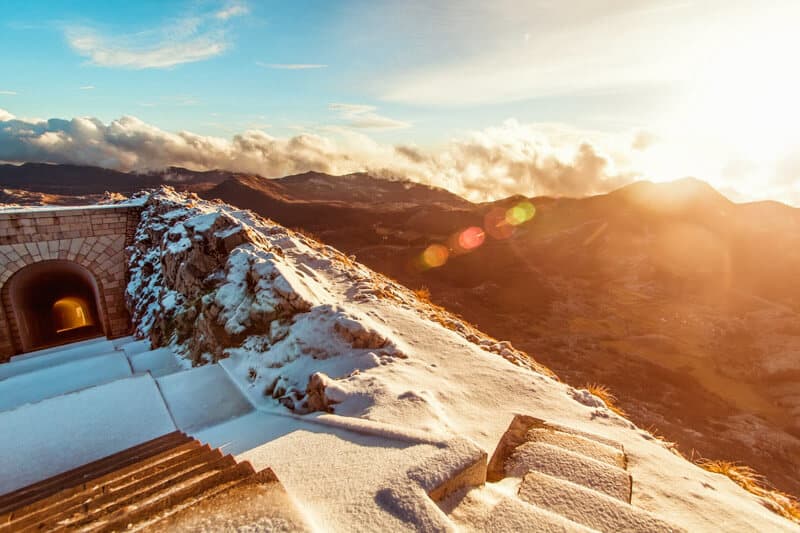
Smaller than Durmitor but offering similarly spectacular mountain scenery, Lovcen National Park sits above Kotor at the south-eastern tip of the bay. From the western side, you can catch a panoramic view of the entire bay – and the best sunset in all of Montenegro.
The highlight is visiting the Mausoleum of Petar II Petrovic-Njegos atop Mount Lovcan (AKA ‘The Black Mountain’, the peak that gives Montenegro its name). Dedicated to Montenegro’s most beloved national hero – a prince, poet and philosopher who was born nearby in Cetinje – it’s a surreal piece of architecture that can only be accessed by climbing a very long set of undercover stairs.
The design, which includes a chapel adorned with 200,000 gold tiles and a pitch-black burial chamber, has divided Montenegrins. Some people love it, others hate it. Whichever way you fall, you’ll agree that the view from the round viewing platform at the back of the mausoleum is hard to beat.
There are two ways to reach the mausoleum: Along the highway from Cetinj, or via the perilous Kotor Serpentine, an 8km stretch of road with no fewer than 16 hairpin turns. As you zig zag your way up (or down) the serpentine, you get unmatched views of the bay.
16. Biogradska Gora
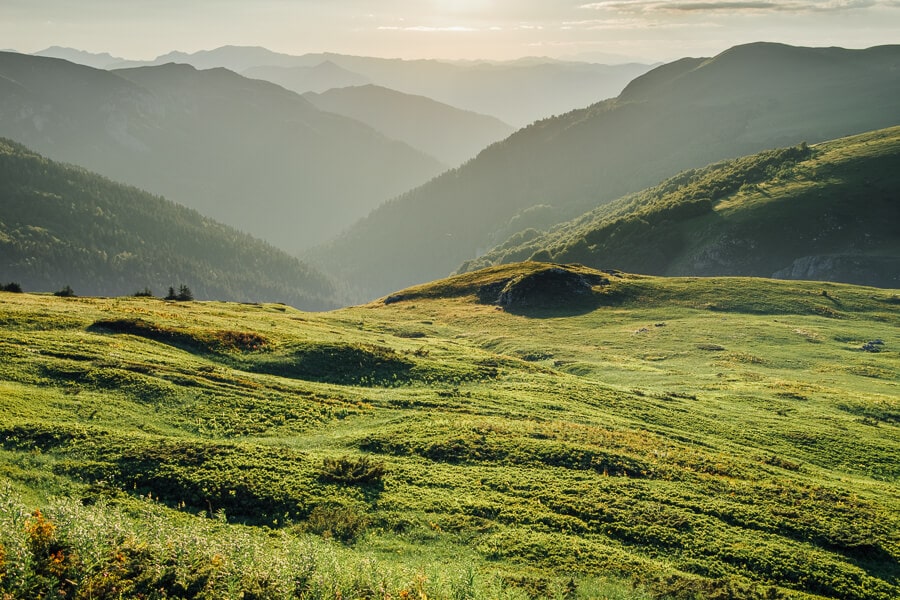
Biogradska Gora is a forest and national park in the mountainous area of Bjelasica in north-eastern Montenegro. Protected as part of the UNESCO World Network of Biosphere Reserves, Biogradska Gora is known for its primeval forests – one of the last three large virgin rainforests in Europe, in fact.
The national park covers an area of 1,600 hectares and has trees that are more than 500 years old. In addition to the untouched forests, there are six glacial lakes including the popular Lake Biograd, which is backlit by green mountains and features a picture-perfect wooden jetty strewn with canoes.
Swift streams travel through Biogradska Gora, and the clear lakes vividly reflect the green pastures and ancient forests. Hiking, fly fishing and water sports are available within the park. In winter, several ski resorts open up nearby. For something special, follow the switchbacks to Bendovac Viewpoint.
17. Prokletije National Park
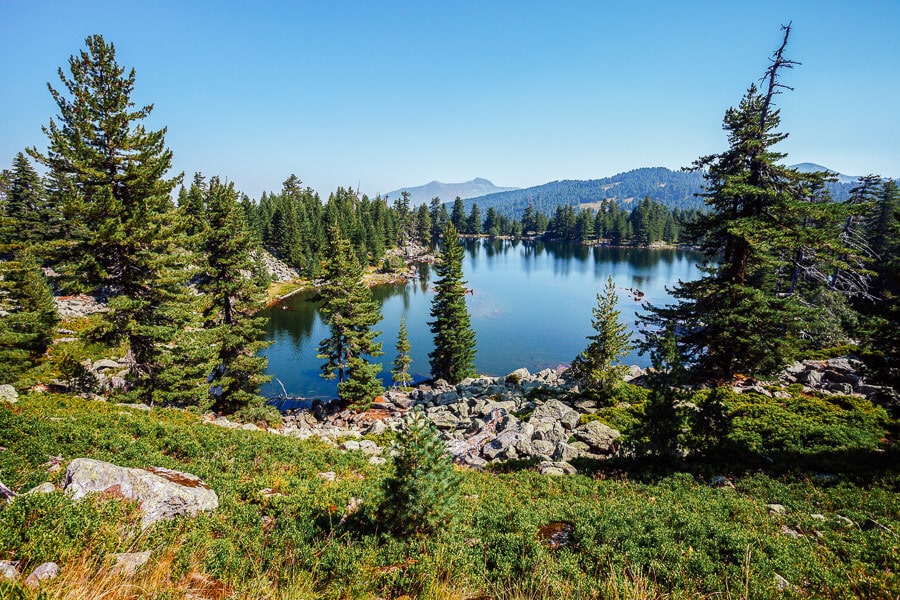
Located in the north-eastern corner of Montenegro close to Kosovo and the Albanian border, Prokletije National Park is the country’s newest protected area, having only been designated a national park in 2009. It covers one of the most stunning parts of the Balkans, the Dinaric Alps mountain range, and some of the best hiking trails in the entire country.
This park transcends borders, extending into Albania where it joins up with two more national parks, Valbona and Theth. A great way to explore the terrain and enjoy spectacular views is by walking the 200km Peaks of the Balkans, a marked loop hike that leads you through the three countries.
Shorter day treks are also on offer to introduce you to Prokletije’s incredible biodiversity: This park is home to half of Montenegro’s native flora. Walk to stunning alpine Hridsko Lake, cool off in the fresh water at Ali Pasha’s Springs, and discover historic towers and churches, some of which date back to the 15th century, along the way.
Guesthouse accommodations are available in the nearby town of Plav, which is also home to a score of beautiful mosques (see more in the next section). Prokletije is around 2 hours from Biogradska Gora National Park. It’s convenient to combine the two when travelling by rental car.
18. Plav
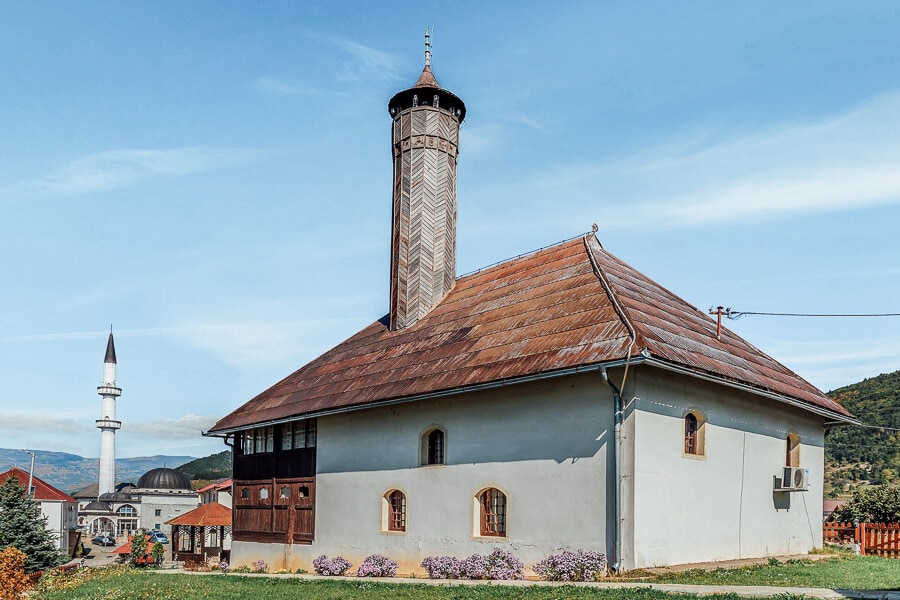
Derived from the Slavic word plav, which translates to ‘a flooded place’, Plav is a town in northeastern Montenegro at the foot of the Accursed Mountains range.
This area is known for its many lakes. The eponymous Lake Plav is one of the largest and most popular, along with Hrid Mountain Lake and the famous floating island of Lake Visitor.
Plav is also popular for its karst springs. Oko Skakavice, one of the strongest, is located in the Prokletije area. The spring’s water is so clear and transparent that the bottom is visible even at its deepest point.
Plav has a rich history tied to the Ottoman Empire. Among the cultural treasures that Plav has to offer are the breathtakingly beautiful 17th-century Redzepagic Tower, and the Byzantine-style Holy Trinity Monastery, which was built in the 12th century and is believed to be older than the nearby Decani Monastery in Kosovo.
19. Lipa Cave
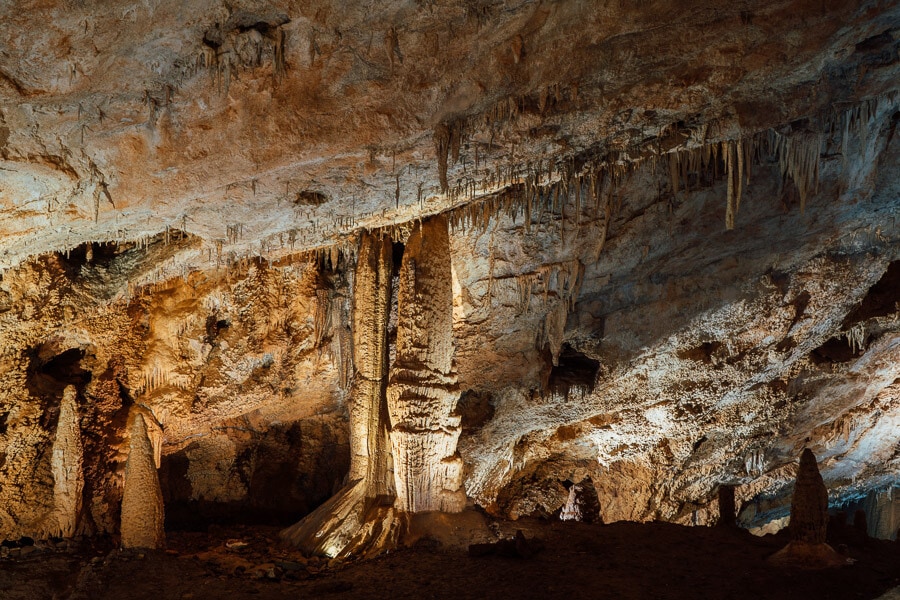
Just outside the Royal Capital of Cetinje, Lipa Cave is one of the largest cave systems in Montenegro and the first to open to tourists. Its tight passageways and voluminous ‘halls’ stretch for more than 2.5km underground, from the village of Lipa into the mountains along the Adriatic coast.
Lipa’s impressive karst rock formations and cathedral ceilings make it one of Montenegro’s most important natural attractions. The first explorations of the cave were organised in the 19th century, but it wasn’t until 2015 that the cave opened to visitors.
The only way to experience this otherworldly landscape is on a Cave Experience tour, which lasts for around 60 minutes and includes a scenic train ride. Reservations should be made online in advance.
20. Tivat
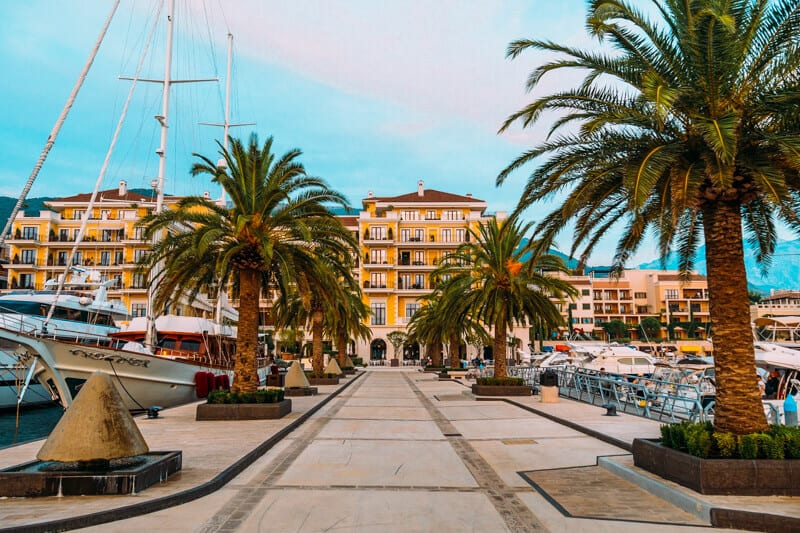
Returning now to the Bay of Kotor, the jewel in Montenegro’s crown, there are yet more gorgeous towns to explore along the pleated coastline.
Tivat has an international airport and a cruise ship port, making it one of the bigger and more touristy cities on the bay. Once a laid-back village, Tivat is now a Monaco-esque harbour city with a modern marina full of bobbing luxury yachts.
Tivat might not be a worthy rival of Kotor, but it’s worth visiting in summer for the many carnivals and fairs that take place. The city is a convenient base for exploring the northern end of the coast, including the Blue Grotto underwater cave, a 40-minute drive away. On the way, you can visit Velja Spila beach and stop in a seaside town for a fresh fish lunch.
21. The Blue Cave

Also known as the Blue Grotto or Plava spilja, the Blue Cave is one of the most popular attractions on the coast of Montenegro. This huge cavern is carved directly from the rock, creating an opening big enough for boats, swimmers and snorkellers to pass through.
The Blue Grotto is the largest of the many sea caves on the Luštica Peninsula and the most beautiful, with a sea level surface of 100 square metres and a high vaulted ceiling. The sunlight piercing through the cave’s opening reflects off the water to turn the entire cave blue – giving this natural wonder its name.
The best way to visit is on a speed boat tour day trip from either Tivat or Kotor. The splendid colour scheme and refreshing waters might remind you of Albania’s Blue Eye.
22. Karuc – a beautiful fishing village in Montenegro
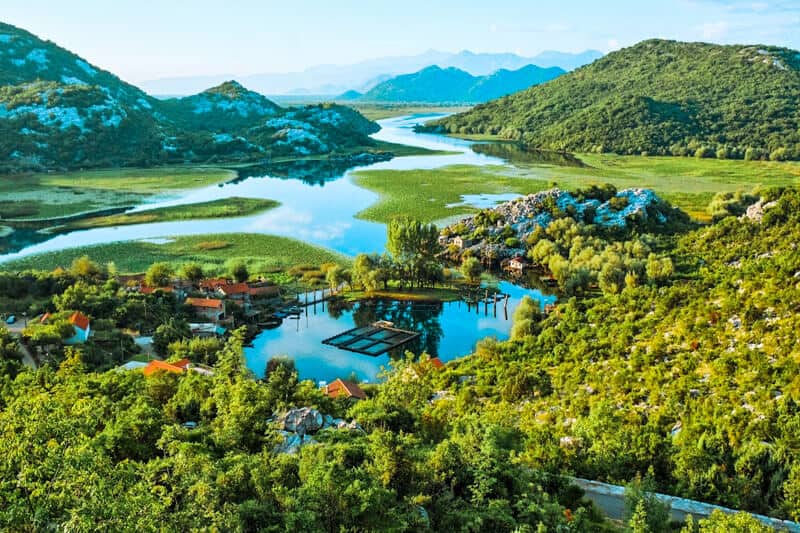
The quaint fishing village of Karuč sits on the edge of Skadar Lake. Rich in history and culture, Karuč was originally a temporary village built for fishermen.
Protected from the wind by a natural curve in the lake, the little harbour known as Karučko oko (Karuč Eye) was known for its abundance of fish even during bleak winters. The stone houses that stand today were used by the fishermen to store equipment in between expeditions Today, some of them have been transformed into seafood restaurants and holiday cabins.
There are many attractions near the village, including Lipa Cave (the largest cave in Montenegro), the spring of Rijeka Crnojevića, and Bobija Hill with more panoramic views of Lake Skadar. Whether you visit by water or land, this is definitely one village you won’t want to miss.
23. Herceg Novi
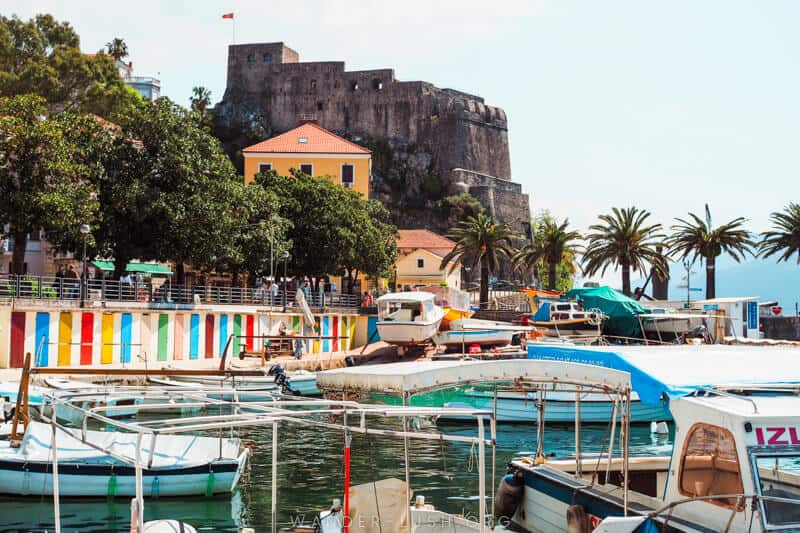
At the extreme opposite end, the coastal city of Herceg Novi sits very close to the Bosnian and Croatian border at the entrance of the bay. Like most towns of a certain age in this part of Europe, Herceg Novi has a turbulent history of conquest and ruin.
Herceg Novi means ‘New Castle’, and the town is recognised for its Ottoman-built Kula Fortress, Bosnian-built Sea Fortress, and of course the Spanish Fortress, all of which tower above the pretty beaches and harbours. To top it off, there’s an Austrian clock tower in the centre of the old town.
Herceg Novi was a popular holiday resort in Yugoslav times. It’s less touristy now, but still buzzes during the summer festival season. While here, be sure to wander the colourful docks and the beautiful Pet Danica promenade that runs the entire length of the seafront.
24. Savina Monastery
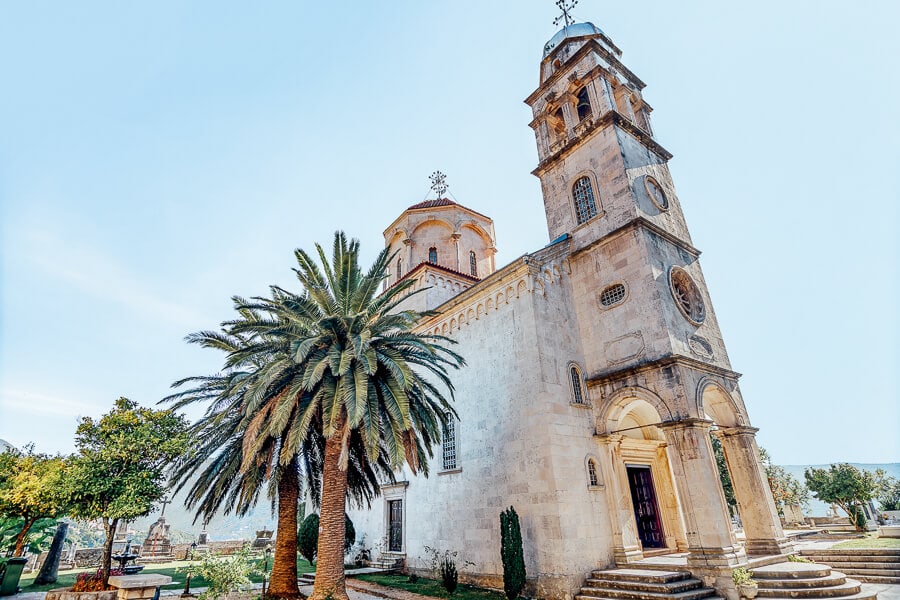
One of the most beautiful monasteries in the Balkans, Savina is a medieval Serbian Orthodox monastery just outside Herceg Novi. Close to the water’s edge and nestled in the lush vegetation of the Montenegrin Littoral, the location is truly breathtaking.
The monastery comprises three separate churches: the small church of the Assumption, the church of St. Sava of Serbia, and the Great Temple of the Assumption. Gorgeous gardens and grounds fringed with tall palm trees complete the scene.
While there is some controversy about how old the monastery actually is, it houses many relics and objects of historical interest dating from the Nemanjić Dynasty (1166-1371) as well as the remains of the wife of Tzar Dusan of Serbia.
Savina faces directly out to the narrow opening where the Bay of Kotor meets the Adriatic Sea. The blue satin sea backdrop is enough to rival even the iconic Church of Saint John the Theologian in Ohrid, Macedonia.
25. Ulcinj
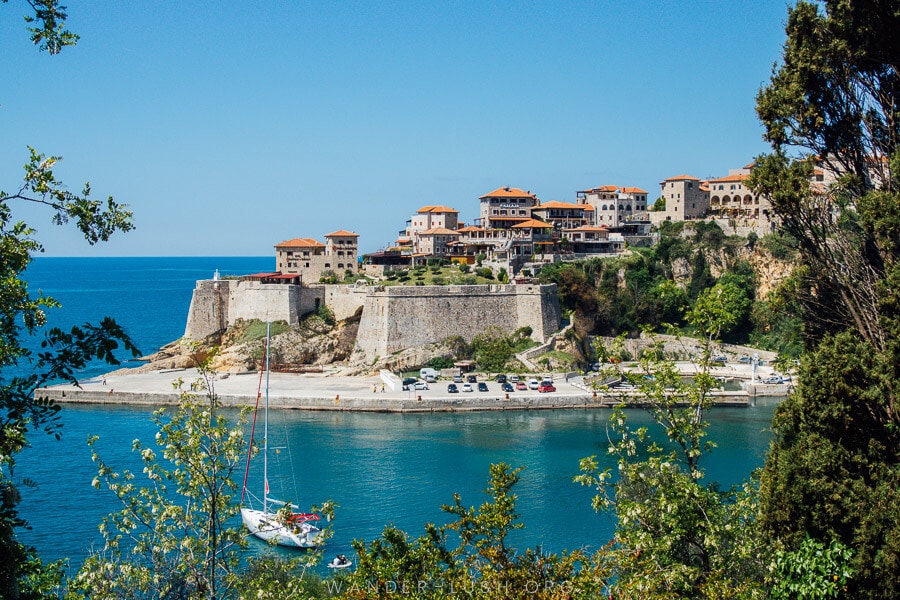
The ancient coastal town of Ulcinj is unlike any other place in Montenegro. Tucked away on the south-eastern coast – a world away from Kotor bay – Ulcinj has a very local feel and is vastly more popular among domestic tourists than international visitors.
This is where you’ll find the country’s most beautiful beaches (the only white sandy beaches in Montenegro): Long Beach, Small Beach and Sapore di Mare among them. More secluded coves and quiet stretches of shore can be found away from the centre.
Home to Montenegro’s largest Albanian community, Ulcinj boasts more than two dozen mosques. The Museum of Local History is a great visit for learning about the town’s past – which goes all the way back to the 5th century BC. To get a feel for modern-day life, head straight to the vibrant produce market.
Ulcinj Castle, one of the area’s most famous landmarks, stands sentinel over the town and beaches and offers beautiful views of the sea.
Because of its close proximity to Albania and Kosovo and the frequency of transport connections (especially in summer), Ulcinj is an ideal departure point for travelling into the neighbouring countries, with direct coaches to Tirana, Prizren and Pristina.
Montenegro essentials
Here are my favourite resources to help you organise your visit to Montenegro.
FLIGHTS: Find affordable flights to Montenegro on Skyscanner.
TRAVEL INSURANCE: Insure your trip with HeyMondo, my preferred provider for single-trip and annual travel insurance.
CAR HIRE: Use Local Rent to hire a budget-friendly car from a local agent (prices start from 15€/day) or jump on the Discover Cars website to hire a car through an international company.
ACCOMMODATION: Find the best hotel and apartment deals on Booking.com, the most popular booking platform in Montenegro.
TOP-RATED MONTENEGRO DAY TRIP: Durmitor, Tara & Ostrog Monastery (from $60/person).
MORE TRAVEL TIPS: Check out this post – 21 things to know before you visit Montenegro.
Plan your trip to Montenegro
If you’re considering a trip to the Balkans, I hope this list of beautiful places in Montenegro has put this underrated nation on your radar!
Here are a few resources to help you plan the perfect itinerary.
- My recommended Montenegro road trip itinerary
- 21 essential things to know before you visit Montenegro
- Essential tips for driving in Montenegro
- 12 things to do in Kotor
- 13 things to do in Perast
- Guide to the Podgorica Bar train
- More Balkans road trip inspiration
More beautiful places to explore
- Beautiful places in Slovenia
- Beautiful places in Croatia
- Beautiful cities in Romania
- Beautiful cities & towns in Hungary
- Beautiful places in Slovakia
- Beautiful places in Turkey
- Beautiful places in Portugal
- Beautiful Italian islands
- Beautiful Italian cities
- Beautiful Spanish cities & small towns
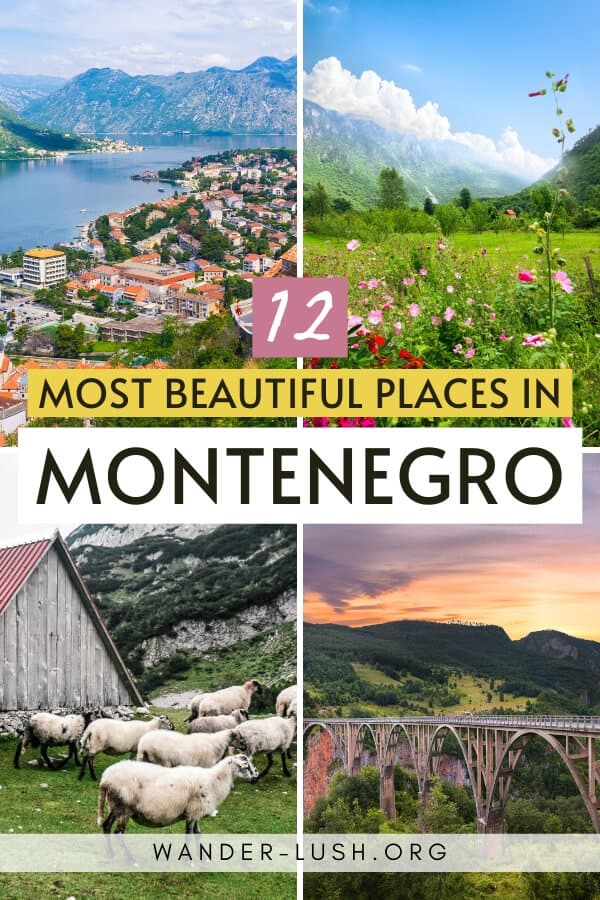
Hi Emily,
Thanks so much for this wonderful post! Even so many years later, I have tried to follow it to a “T”! Have just driven around Montenegro for 2 odd
days and seen so much thanks to you!!
Wonderful to hear! Thanks for your comment, Uday!
these are stunning places! Montenegro was on my list for 2020. will have to check it out when things reopen!! hope its very soon 🙂
I hope so too, Jackie!
I’ve been to most of these since my husband is from Montenegro!
That’s terrific Brooke! I love Montenegro, such an underrated destination!
Nice itinerary, Perast is number one for me as well!
Thank you for this informative guide full of details and pictures! We will be visiting this region for a month or so and your guide has been excellent for planning.
Glad to hear that, Travis! Enjoy your travels to Montenegro!